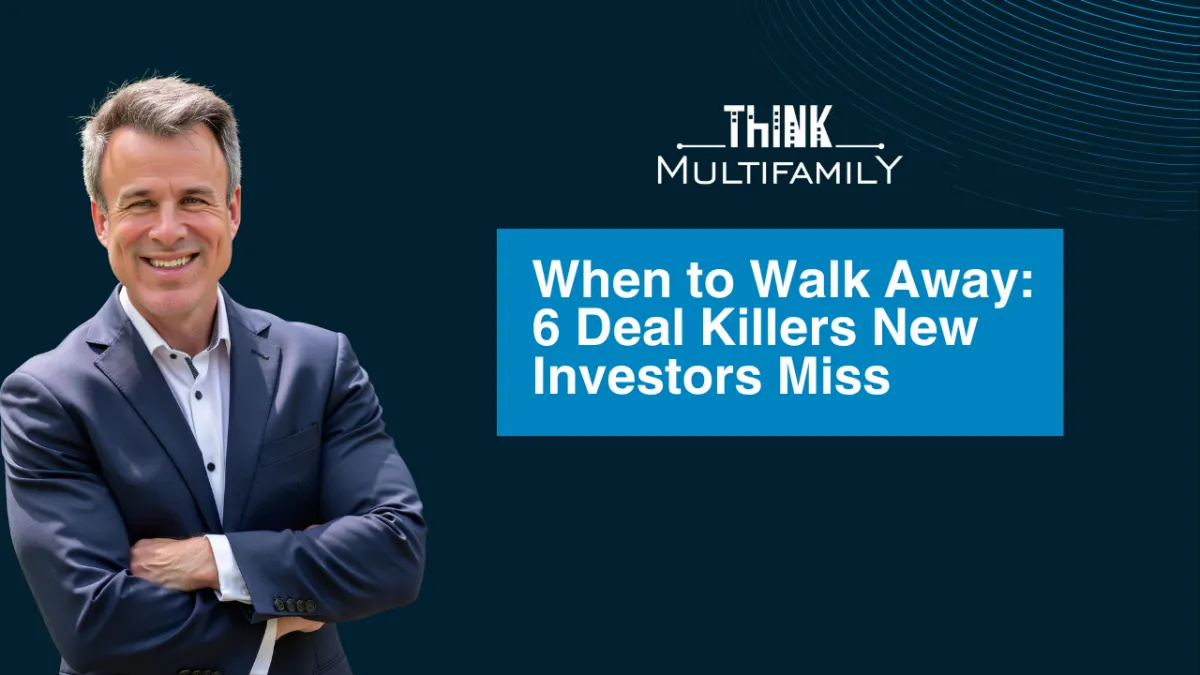
When to Walk Away: 6 Deal Killers New Investors Miss
Think Multifamily | Mark Kenney
When you’re chasing your first deal, it’s easy to fall in love with the possibility. You finally find something that almost pencils. The broker is hyped. Your coach says you should make an offer. And you start telling yourself those red flags are “fixable.”
But here’s the truth: not every deal is worth doing.
One bad deal can sink your reputation, drain your capital, and kill your momentum before you ever really get started. Knowing when to walk away isn’t weakness—it’s wisdom.
These six red flags show up often in first-time deals. If you spot one—or worse, a few—it’s time to pause, step back, and consider walking away.
1. Poor Visibility or Awkward Access
The problem: The property is tucked behind warehouses, down an unlit road, or requires a hair-raising left turn across four lanes of traffic just to get in.
That’s not just an annoyance. That’s a leasing issue waiting to happen.
Why it matters:
Hard-to-find properties are hard to fill.
Poor access means fewer tours, fewer drive-bys, and higher marketing costs.
Geography isn’t fixable. If people can’t find it easily, occupancy and rent will always suffer.
What to check:
Pull it up on GPS—would you want to drive there?
Look at traffic flow and ingress/egress.
Walk the block: what’s around it (junkyards, industrial, strip clubs)?
2. Roofs or Plumbing at the End of Life
Deferred maintenance is one of the biggest silent deal killers. You may think, We’ll phase it in over time. But if you’re looking at a 30-year-old roof or galvanized plumbing throughout, you’re not buying a cash-flowing asset. You’re buying a rehab project.
Why it’s dangerous:
These are big-ticket repairs that hit immediately.
They eat into cash flow right when you need stability.
“We’ll deal with it later” often turns into capital calls—or worse, a hit to your reputation.
What to do:
Always order third-party inspections—even on so-called “turnkey” deals.
Budget for full replacement, not just patches.
If the seller can’t show documentation or warranty status, assume the worst.
3. Pro Forma Still Shows Negative Cash Flow
Here’s a massive red flag: you plug in 90% occupancy, market rents, and normal expenses… and the deal still doesn’t cash flow.
That’s not a “value-add.” That’s a liability.
Signs of trouble:
You’re relying on unrealistic rent jumps.
You’re assuming ultra-low expenses.
You need a lightning-fast lease-up just to break even.
👎 Walk-away rule: If it doesn’t cash flow under reasonable assumptions with real comps, move on. Hoping to “force appreciation” won’t save you if you’re negative from Day One.
4. The Neighborhood Has No Momentum
You’re not just buying the building. You’re buying the block, the schools, the employers, the shopping, and the job access that surround it.
If nothing’s changed in the past five years—and nothing’s planned—you’re fighting gravity.
Red flags:
Flat or declining home values
Zero new development within three miles
Poor schools, no major employers, no transit or retail anchors
What to look for instead:
Early signs of gentrification (coffee shops, retail upgrades, new grocery)
Infrastructure improvements
Announced job growth or new employers coming in
You can’t raise rents in an area where incomes and demand are stagnant.
5. Legal or Tenant Issues
Maybe the tenants are all on handshake leases. Maybe the seller has been playing games with rent control. Maybe there’s a stack of unresolved habitability complaints.
That’s not an opportunity—it’s a liability.
Risks include:
Fines from code enforcement
Costly legal battles
Reputational damage
Questions to ask:
Are all leases written and enforceable?
Are there undisclosed Section 8 or LIHTC tenants?
Does the legal risk outweigh the upside?
If the answer isn’t clear, walk.
6. The Numbers Say Yes… But Your Gut Says No
Sometimes the math checks out. The broker is smooth. Everything looks fine on paper. But something in your gut says otherwise.
Listen to it.
Maybe the seller’s story keeps shifting. Maybe the PM seems too casual. Maybe the whole process feels rushed.
Why it matters:
Your subconscious often catches what your spreadsheet misses.
Many burned investors say, “I knew something felt off—I just ignored it.”
If it feels wrong, it probably is. And there’s always another deal.
Final Thought
It’s easy to say yes. It takes real wisdom to say no.
As a first-time investor, walking away might feel like missing your big shot. But every experienced operator will tell you: saying no to the wrong deal is what gave them the space to say yes to the right one.
Because every time you walk away from the wrong deal, you’re saying yes to staying in the game.
🎯 Want to Avoid Rookie Mistakes?
The Multifamily Fast-Track System gives you the blueprint to source, fund, and operate apartment deals—built from 120+ deals and $1B+ in experience. All for just $7.
⚠️ One wrong move can cost you thousands. Don’t go it alone.
[Apply for Coaching Now] and get the accountability and guidance to buy apartments with confidence.